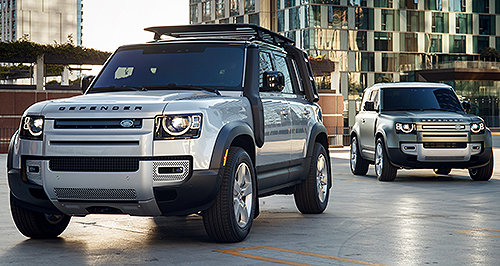CES: Dual eSIM connectivity for Land Rover Defender

LAND Rover has stepped up its connectivity game with the new Defender at this year’s Consumer Electronics Show in Las Vegas, debuting a new dual-modem, dual-eSIM system for its Pivi Pro infotainment set up.
Powered by two Qualcomm Snapdragon 820Am Automotive Platforms, the system has been designed to enhance the Defender’s connectivity and infotainment functionality by dedicating one of the modules solely to managing Jaguar Land Rover’s Software-Over-The-Air (SOTA) updates while the other handles the regular infotainment tasks like streaming music.
Land Rover says the result is seamless software updates with no interruptions to music streaming or other app functions.
Jaguar Land Rover director of connected car and future technology Peter Virk said the new Defender “has the digital capacity to keep customers connected, updated and entertained at all times anywhere in the world.”
“You could liken the design to a brain, with each half enjoying its own connection for unrivalled and uninterrupted service,” he said.
“Like the brain, one side of the system looks after logical functions, like SOTA, while the other takes care of more creative tasks.”
According to Land Rover engineers, the new system will relegate in-dealer software updates to a thing of the past by the end of next year as the number of updatable modules grows from the current 16 to more than 45.
Extra features of the new Pivi Pro system include being able to connect two mobile devices via Bluetooth to the car at the same time while LTE connectivity allows the system to jump between networks and maintain maximum connectivity, minimising reception black spots.
Away from the entertainment side of Pivi Pro and sitting squarely in the ‘info’ part of the word infotainment is the new Blackberry QNX operating system which, among other things, powers the latest-generation TFT interactive driver display.
Drivers can configure the display to show either vehicle instrumentation, navigation instructions and mapping information or a combination of the two.
To smooth over the ease of use, the QNX Hypervisor consolidates more systems onto fewer ECUs, something Land Rover says will be an integral part of its next-generation vehicle architectures.
Built on-top of the hypervisor is also a domain controller responsible for consolidating a number of advanced driver assistance systems and driver convenience functions built around the hypervisor.
Safety features and the relating technology are always hot topics at CES and 2020 is no different for Land Rover which is showing off its latest advanced driver assistance systems developed in collaboration with Bosch.
A new 3D surround-view camera system takes the top step as the biggest development in this area which uses four wide-angle cameras – each with 190-degree field of view – and 14 ultrasonic sensors to provide the driver with a unique view of the vehicle’s immediate perimeter.
In tight off-road environments or carparks, drivers are able to use the infotainment screen to pan around the perimeter of the car and check for obstacles and their proximity.
Advanced new blind spot assist has also been developed with the help of Bosch which has been working with Land Rover for more than a decade.
Back on the entertainment front, Land Rover has become the first car-maker to use CloudCar’s latest cloud-based services platform which includes a QR function to recognise the driver’s “digital life” and add the relevant streaming or other app accounts such as Spotify, TuneIn and Deezer to the infotainment system.